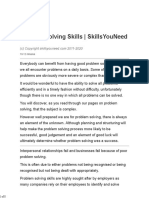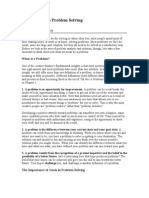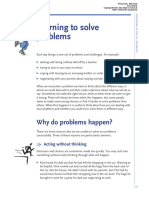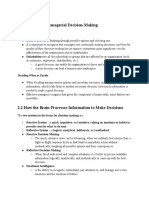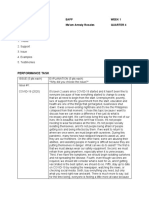Problem solving
For people living with health conditions
Dealing with problems, set-backs or dilemmas is part of life. We all struggle with this. Like many
others, you may be facing a mix of small day-to-day problems as well as life’s big challenges. No
matter how big or small the problem, we all need ways of facing these problems and solving them
if we can. People with health problems may face particular problems related to their condition that
test their coping and problem solving skills. This booklet offers advice and information about problem
solving skills and about coping when problems are not easy to solve. You may wish to read it in small
chunks, or with the support of a friend or family member.
Problems can come up in lots of different areas of your life. They may be related to your finances,
relationships, friendships, work or study. They may be about a missed train, a leaky roof, a puncture
or a missing set of keys.
Having a health condition can add an extra set of challenges to be overcome. You may struggle with
arranging hospital appointments around childcare and work, managing flare ups of your symptoms,
dealing with fatigue or pain, making big or small decisions about your treatment, managing
relationships with health care professionals and communicating with others about your condition,
to list just a few.
1
�Common effects of problems
Here are some common examples of how living with unsolved problems can affect you physically and
emotionally as well as affecting what you think and the choices you make.
The way you think
n spending a lot of time focused on the problem
n churning it over in your mind a lot
n thoughts about the problem popping into your mind when you don’t want them to
n imagining the worst case scenario.
The way you feel
n anxious, tense, panicky and on edge
n feeling ‘dread’ when you think about the problem
n feeling ‘fed up’, ‘not bothered’ or indifferent, particularly if it has been going on for a long time.
Your body
n tense muscles, aches & pains
n fatigue
n poor sleep and disrupted appetite
n flare ups of symptoms affected by stress.
The things you choose to do
n try to avoid thinking about the problem OR chew it over constantly
n avoid tackling the problem by staying busy with other things
n use alcohol, drugs, cigarettes or food to try to feel better
n keep on trying the same solution, even if it has not worked in the past
n spend a lot of time surfing on the internet, get second opinions, request more medical tests.
Why am I struggling?
It is understandable that people with health problems struggle with the demands of their conditions
which can be unpredictable, uncomfortable and draining. However, many people with health
problems feel bad that they are struggling or that they have not been able to overcome the problems
they face.
You may recognise thoughts like, “I should have sorted this by now”, “I should have got over this by
now” or “I wouldn’t have this problem if I was strong enough or determined enough”. Usually these
thoughts are overly harsh, likely to be untrue and definitely unhelpful.
It is likely you have often tried lots of things to help yourself already and showed great determination
and effort. It is also likely that if it was an easy problem to solve you would have solved it! This means
that perhaps your problems are not so easy to solve after all and that it is not your fault that you have
not yet sorted them out.
Some difficult problems need a structured approach to solving them. Below are an important series
of steps which will help you tackle problems in an effective way. Each step is an important one. Try
not to skip steps along the way!
Problem solving steps
1. Define the problem(s)
2
�What exactly are you up against? Try to complete this sentence; “The problem I am facing
is____________________.”
2. Prioritise
If you have several problems write a list. Choose two or three problems from the list and order them
from least important to most important. Put a circle around the one you have chosen to work on.
If you find your mind wandering to the other problems, gently remind yourself that for now you are
focusing on just one problem at a time.
3. Ask yourself
Is this a problem I can do something about, or is it outside my control?. Some problems cannot be
solved by individuals, despite their best efforts. For example, public transport being on time, the
weather or the choices and behaviours of other people may be outside your control.
If you believe that there is something you can do about the problem you face, continue following the
steps below. If the problem is outside your control at the moment go to page 8.
Serenity poem
Give me grace to accept with serenity
The things that cannot be changed,
Courage to change the things
Which should be changed,
And the wisdom to distinguish
The one from the other
4. Brainstorm
List as many possible solutions to the problem as you can. Write down everything from the most
simple to the far fetched and funny. This will help you to start thinking flexibly and considering lots of
options.
For example, if the problem is “I need to get to the hospital but there are engineering works on the
train line I need” you might generate the following;
n walk 10 miles to get there
n hire a limo or a helicopter
n take a taxi
n check for rail replacement buses
n cancel and reschedule the appointment
n see if there is an alternative train route
n ask a neighbour for a lift in return for some baby sitting later.
5. Choose one
Take a step back and review the solutions you have come up with. Which one do you believe will help
you to move closer to solving the problem? Try to choose something manageable and realistic from
the list.
3
�6. Make a plan
Decide when, where, and how you will carry out the solution you have chosen. Try to be as detailed
as possible. Write it down and put it somewhere you can see it.
7. Beware of jumping ahead or getting side-tracked!
It is common to start off enthusiastically with these steps and then get distracted by other things. To
give yourself the best chance of success put a reminder in your phone or tell a friend what you plan
to do.
Also, it is common to unintentionally skip some steps and jump into doing things. Try not to fall
into this trap. The steps are an important tool for helping you approach problems effectively and for
helping you learn from what went well and what did not work so well.
8. Now do it!
9. Review how it went
Did it go to plan? Did it move you closer to solving the problem? If it did not go to plan, perhaps you
can break the solution down into smaller more manageable parts or go back to the list to choose
another option.
10. Repeat
If the problem is not yet solved, go through these steps again.
Problem solving steps summary:
1) What is the problem(s)?
2) Prioritise a problem
3) Is there something you can do about this problem?
4) Brainstorm solutions
5) Choose one solution
6) Make a plan
7) Remember not to get side-tracked or jump ahead
8) Now do it!
Trouble shooting
The steps above might sound simple and straightforward. But what if you get stuck? What if it is
very difficult to get closer to solving the problem? Below are some suggestions to help you with the
problem solving steps.
What has worked before? Have you faced this problem before? If so, what have you tried in the
past? Did it work? If it worked then, can you try it again now? Perhaps you have not faced this
particular problem before but have faced other dilemmas. Are there any skills or strategies you have
used then that you could use now?
What have you tried before that has not worked? You may have tried things in the past that turned
out to be unhelpful or maybe only worked in the short term. If your experience tells you that these
solutions have not worked on the past, perhaps they are unlikely to work now. Try not to to re-use old
problem solving strategies that have not helped.
4
�Take a different perspective. If a friend was in a similar situation, what would you advise them to
do?
Two heads are better than one. Ask a friend or family member to help you come up with possible
solutions.
Accept help. Maybe this is a problem that cannot be easily solved alone. Many people with health
problems worry about being a burden on others and work hard to be independent. However, perhaps
asking others for help is sometimes part of the solution. Try to imagine how you would feel about
being asked for help by a friend or family member who was struggling. Would you see them as a
burden and begrudge giving help or would you be glad to have a helping role from time to time?
Be a detective. You may not have all the information you need to solve the problem or to come up
with new solutions. Try asking your healthcare professionals for more information about the health
dilemma you face. If possible, go to your consultation with specific questions written down to help you
use the time well.
If you choose to use the internet, stick to websites that are likely to have accurate and helpful
information. NHS Choices is usually a good place to start and websites ending in .ac.uk or .org.uk are
usually reliable. Beware of general browsing of the internet for information about your condition as
many websites contain information which may not be accurate and may exaggerate risks.
“Are we there yet?” Perhaps despite your efforts the problem is not yet solved. You have not
‘arrived’ at your destination. Maybe you are feeling disheartened and fed up. If this happens, review
what you have tried and ask yourself “Has this got me closer to solving the problem?”. You may not
be ‘there yet’ but you may be moving in the right direction on the right road. If your experience tells
you that you are moving in the right direction, keep going!
Learn from your attempts. You might try a solution that doesn’t work out. Try not to get
disheartened. Instead, try to learn from this. It is as important to know what doesn’t work as to know
what does.
Give credit where credit is due. Acknowledge your effort and persistence and note your successes,
however small. Remember that living with health problems is not always easy and that there will be
setbacks. Try not to let set-backs overshadow your good work.
Is it worth it? Solving problems is challenging. It can be very demanding of time and energy.
Sometimes getting wrapped up in solving a problem can mean losing touch with other things that are
important in your life. Take a moment to ask yourself what does it cost you to solve this problem (e.g.
time with family, time spent doing pleasurable activities) and is the outcome you are looking for worth
it?
Your answer may be ‘Yes’ it is worth it. However, you might decide to accept the problem as it is,
without trying to solve it, and find other ways to live a rich and meaningful life for now, perhaps
returning to the problem later.
Take a step back. If your efforts have not produced the results you wanted, despite all your best
efforts, ask you self the following question again, “Is this something I can do something about or it is
out of my control?”. If you believe that actually you cannot do much about the problem, read on for
ideas about how to cope. If your experience tells you there is more you can do, continue using the
problem solving steps.
5
�What if solving the problem is not under your control?
Perhaps it was clear from the beginning that solving the problem would be out of your control and you
have skipped to this section. However, it is also possible that you have been trying hard to solve it for
a long time. Maybe you have just taken a step back from the problem and wondered whether, right
now, it is not possible to solve.
You may be having thoughts like “I’m not working hard enough” or “I’m not persistent enough”, which
probably make you feel bad, even though these thoughts may not be true and are unlikely to be
helpful.
Perhaps external factors you cannot control, like economic or political changes, have made it difficult
to solve the problem. Or perhaps at this point in time you don’t have the resources you need to
solve the problem (e.g. time, money, energy). These things are not your fault and are not under your
control, so try not to fall into the trap of being hard on yourself.
How can I live with these problems?
Even if the problems you face are not within your control, there are still things you can do and
there is hope. These strategies will not make the problem go away. Instead, they will help you to be
less bothered by the problem and aim to help you live a rich and meaningful life, even though the
problems are still there.
Accept your situation
Try to accept that, for now, you cannot change the situation you are in. This is not always easy.
Giving up looking for a solution can be very difficult.
Remember, accepting your situation is not the same as ‘giving in’ or ‘giving up’. Instead, it is about
letting go of the struggle you have with the problem. You can do this by making room for it in your
life and allowing it to be there, instead of trying to get rid of it. Importantly, you don’t have to like the
problem or want it in your life, just make space for it to be there.
Accepting the problem is like having an unwanted, loud guest at a party. You don’t have to like them
but you may have to offer them a seat.
Manage your thoughts and feelings
Once you decide to accept your problem and begin to let go of the struggle with the problem, you will
naturally have different thoughts and feelings that come up. You might have thoughts like “I’ll be stuck
with this awful problem forever” and feeling angry, frustrated and sad. This is a normal reaction.
Many people fall into the trap of trying to push these thoughts and feelings away. However, this just
makes them come back even stronger. For example, try NOT to think of a Pink Elephant right now.
How did you do? Did you manage to keep the image out of your mind? If you are like most other
people, probably not!
Mindfulness
Instead of trying to push difficult thoughts and feelings away, you can learn new ways of being less
caught up in your thoughts and feelings and eventually less bothered by them. One way of doing this
is to practice mindfulness.
6
�Mindfulness is about paying attention in a particular way. It invites you to take a curious and non-
judgemental attitude towards whatever you are experiencing in the ‘here and now’. Try these simple
steps;
n �Focus first on your breath. Pay attention to the natural rhythm of your breath. Notice the rise
and fall of your chest and stomach. Notice how the breath feels coming in and out of your nose.
Pay attention to any changes in your breath. Don’t be concerned if you notice your mind has
wandered off. This is normal. Just gently bring it back to the breath.
n �Thoughts, feelings and sensations will continue to come up and try to grab your attention. This is
normal. Instead of pushing them away, or judging them as bad or a nuisance, just observe them,
as if they were leaves on a stream or cars driving by outside. Then bring your attention gently
back to the breath.
As you become more skilled at using mindfulness, it can help you be less bothered by difficult or
painful thoughts and feelings about the problem. You will learn to observe them and notice them
without getting caught up in a struggle with them.
Being mindful of your experiences is a very different way of paying attention and it takes practice.
There are many good books and CDs about mindfulness and about how to apply it to your everyday
life if you think this approach might be helpful for you and you would like to learn more.
Do what matters to you
Even though you may not be able to solve some problems in your life there are still ways of living a
full and vibrant life. Focus on things you can control that make your life better.
Ask yourself the following questions;
n What do I really value in life?
n What gives me pleasure?
n What gives me satisfaction?
n What gives me meaning?
n How often do I do the things that connect me with my values?
n How often do I do the things that give me pleasure, satisfaction and have meaning?
Perhaps, like many people you have lost touch with the things that are really important in your life.
It is possible that you have been working so hard at trying to get solve a particular problem that the
things that really matter have been neglected.
Write down the things in life you really value and think about what you would be doing if you were
living a life that fitted with these values. For example, if your value was to be a good parent you might
decide to spend more time with your children. If your value was health and well-being, you might
make changes to your weekly shop, cutting down on fatty food or alcohol, or do more exercise.
If your value was fun and humour, you might meet with friends who make you laugh.
Now, make a plan for when and how you are going to do things that fit with your values. You can use
the problem solving steps if you get stuck.
7
�Solve the solvable
Even though you may be faced with a big problem that is outside your control, this does not mean
you have no control over your life and other problems. Continue to take on other challenges that are
solvable, starting with manageable tasks, and give yourself credit when you succeed.
Next steps
n Plan a time to use the ideas in this leaflet
n Share the ideas with someone who can support you
n If you have tried the ideas in this leaflet and you have not seen any improvements, talk to your
healthcare professional about getting further support.
Further reading
Manage Your Mind. The Mental Fitness Guide. By Gillian Butler and Tony Hope.
King’s Patient Advice and Liaison Service (PALS)
This is a service that offers support, information and assistance to patients, relatives and visitors.
They can also provide help and advice if you have a concern or complaint that staff have not been
able to resolve for you. The PALS office is located on the ground floor of the Hambleden Wing, near
the main entrance on Bessemer - staff will be happy to direct you.
Tel: 020 3299 3601 Fax: 020 3299 3626 Email: kch-tr.pals@nhs.net
Written by Dr. Claire Doyle, Clinical Psychologist, and Dr. Jane Hutton,
Consultant Clinical Psychologist.
Comms no: 0834 Produced March 2014













